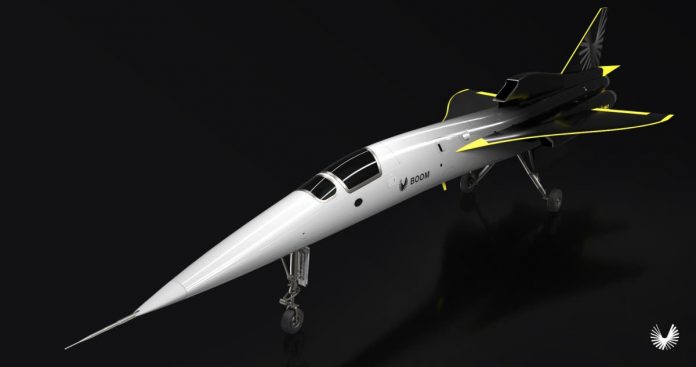Boom Supersonic has chosen October 7th as the date of its new aircraft real-life roll out. The firm has been developing supersonic jet technologies for the last few years, but this is the first time it will have a completed prototype aircraft to show off to the public.

What is the Boom Supersonic XB-1?
Boom Supersonic’s mission is to bring back supersonic travel and become the first private company in the world to build faster than sound transport.
“If we can fly twice as fast, the world becomes twice as small, turning far off lands into familiar neighbors.” – Boom Supersonic’s Mission Statement
So far, they have raised $141m (£107m) to build a small prototype design called the XB-1.

The XB-1 is a one third scale trijet with a top speed of Mach 2.2, with over 1,000 nautical miles (1,900 km) of range.
“With XB-1, we’re demonstrating that we are prepared to bring back supersonic. We’re ensuring that the supersonic future is safe and environmentally, and economically sustainable. We’ve learned that the demand for supersonic has grown even faster than we anticipated.” – Press release statement
This ‘baby boom’ will only seat one pilot (an experienced US Air Force test pilot) and will undergo testing at the famous Edwards Airforce Base (testing site for many of the US Air Force supersonic jets). Most impressive is the development time of the product. Boom Supersonic was only founded in 2014 and has quickly built a prototype in only six years, significantly faster than the development of the Concorde.
So far, the public has not seen the aircraft (as it is still under assembly and just had its wings mated to the main fuselage), but that is all about to change. On October 7th, 2020, the firm will reveal its work so far and roll it out to the tarmac.
The aircraft will not fly or perform supersonic flight tests until 2021.

What will be after the XB-1?
When the XB-1 has a successful test flight, Boom Supersonic will move onto the bigger passenger transport model.

Called the ‘Boom Overture,’ it will have 55-seats onboard, fly Mach 2.2 and reach a range of 4,500 nautical miles (8,300 km). the 55-seat configuration was chosen as that was the average number of business class seats found on board other aircraft types.
Work on the bigger aircraft will start by the end of 2021.
“The completion of XB-1’s assembly marks a turning point in commercial viability for supersonic travel. XB-1 leads the way for Overture development by providing continual learnings for the program.”
The aircraft will be sold directly to airlines, with carriers like Japan Airlines and carrier magnate Richard Branson investing ahead of time to secure the first few aircraft. The finished product will cost $200 million apiece (roughly half the price of the Boeing 777X) and maybe in our skies by 2025.

“You’ll be able to fly Overture for a quarter the price of a Concorde ticket, or about the same price you’d pay in business class today. That’s the most important thing,” – Blake Scholl, CEO of Boom Supersonic.
What do you think? Are you excited about the second age of supersonic travel? Let us know in the comments.
[ad_2]
Source link

